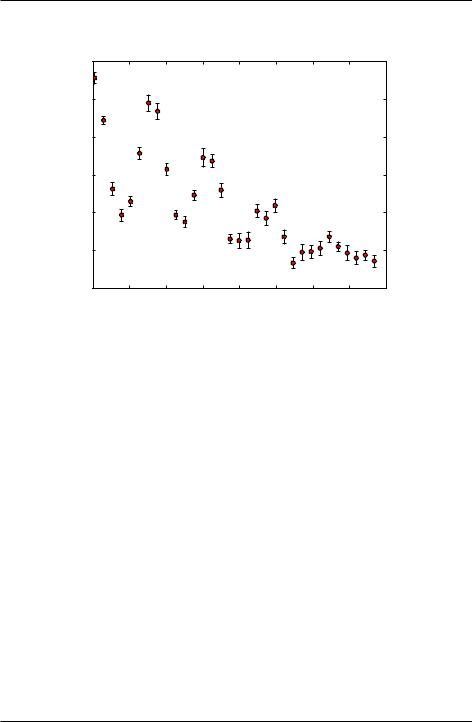
- •Introduction
- •Introduction to Python and its use in science
- •Launching Python
- •Installing Python on your computer
- •The Canopy window
- •The Interactive Python Pane
- •Interactive Python as a calculator
- •Python Modules
- •Variables
- •Importing Modules
- •Getting help: documentation in IPython
- •Programming is a detail-oriented activity
- •Exercises
- •Strings, Lists, Arrays, and Dictionaries
- •Strings
- •Lists
- •NumPy arrays
- •Dictionaries
- •Random numbers
- •Exercises
- •Input and Output
- •Keyboard input
- •Screen output
- •File input
- •File output
- •Exercises
- •Plotting
- •An interactive session with pyplot
- •Basic plotting
- •Logarithmic plots
- •More advanced graphical output
- •Exercises
- •Conditionals and Loops
- •Conditionals
- •Loops
- •List Comprehensions
- •Exercises
- •Functions
- •Methods and attributes
- •Exercises
- •Curve Fitting
- •Exercises
- •Numerical Routines: SciPy and NumPy
- •Special functions
- •Linear algebra
- •Solving non-linear equations
- •Solving ODEs
- •Discrete (fast) Fourier transforms
- •Exercises
- •Installing Python
- •IPython Notebooks
- •Python Resources

Introduction to Python for Science, Release 0.9.23
8.3 Exercises
1.When a voltage source is connected across a resistor and inductor in series, the voltage across the inductor Vi(t) is predicted to obey the equation
V (t) = V0e t |
(8.10) |
where t is the time and the decay rate = R=L is the ratio of the resistance R to the inductance L of the circuit. In this problem, you are to write a Python routine that fits the above equation to the data below for the voltage measured across an inductor after it is connected in series with a resistor to a voltage source. Following the example in the text, linearize the (8.10) and use a linear fitting routine, either the one you wrote from the previous chapter or one from NumPy or SciPy.
(a)Find the best values of and V0 and the uncertainties in their values and
V0 .
(b)Find the value of 2r for your fit. Does it make sense?
(c)Make a semi-log plot of the data using symbols with error bars (no line) and of the fit (line only). The fit should appear as a straight line that goes through the data points.
(d)If the resistor has a value of 10.0 k , what is the value of the inductance and its uncertainty according to your fit, assuming that the error in the resistance is negligibly small.
Data for decay of voltage across an inductor in an RL circuit
Date: 24-Oct-2012
Data taken by D. M. Blantogg and T. P. Chaitor
time (ns) |
voltage (volts) |
uncertainty (volts) |
0.0 |
5.08e+00 |
1.12e-01 |
32.8 |
3.29e+00 |
9.04e-02 |
65.6 |
2.23e+00 |
7.43e-02 |
98.4 |
1.48e+00 |
6.05e-02 |
131.2 |
1.11e+00 |
5.25e-02 |
164.0 |
6.44e-01 |
4.00e-02 |
196.8 |
4.76e-01 |
3.43e-02 |
229.6 |
2.73e-01 |
2.60e-02 |
262.4 |
1.88e-01 |
2.16e-02 |
295.2 |
1.41e-01 |
1.87e-02 |
328.0 |
9.42e-02 |
1.53e-02 |
360.8 |
7.68e-02 |
1.38e-02 |
8.3. Exercises |
153 |

Introduction to Python for Science, Release 0.9.23
393.6 |
3.22e-02 |
8.94e-03 |
426.4 |
3.22e-02 |
8.94e-03 |
459.2 |
1.98e-02 |
7.01e-03 |
492.0 |
1.98e-02 |
7.01e-03 |
2.Small nanoparticles of soot suspended in water start to aggregate when salt is added. The average radius r of the aggregates is predicted to grow as a power law in time t according to the equation r = r0tn. Taking the logarithm of this equation gives ln r = n ln t + ln r0. Thus the data should fall on a straight line if ln r is plotted vs ln t.
(a)Plot the data below on a graph of ln r vs ln t to see if the data fall approximately on a straight line.
Size of growing aggregate
Date: 19-Nov-2013 |
|
|
Data taken |
by M. D. Gryart and M. L. Waites |
|
time (m) |
size (nm) |
unc (nm) |
0.12 |
115 |
10 |
0.18 |
130 |
12 |
0.42 |
202 |
14 |
0.90 |
335 |
18 |
2.10 |
510 |
20 |
6.00 |
890 |
30 |
18.00 |
1700 |
40 |
42.00 |
2600 |
50 |
(b)Defining y = ln r and x = ln t, use the linear fitting routine you wrote for the previous problem to fit the data and find the optimal values for the slope and y intercept, as well as their uncertainties. Use these fitted values to find the
optimal values of the the amplitude r0 and the power n in the fitting function r = r0tn. What are the fitted values of r0 and n? What is the value of 2r? Does a power law provide an adequate model for the data?
3.In this problem you explore using a non-linear least square fitting routine to fit the data shown in the figure below. The data, including the uncertainties in the y values, are provided in the table below. Your task is to fit the function
d(t) = A(1 + B cos !t)e t2=2 2 |
+ C |
(8.11) |
to the data, where the fitting parameters are A, B, C, !, and .
(a)Write a Python program that (i) reads the data in from a data file, (ii) defines a function oscDecay(t, A, B, C, tau, omega) for the function d(t) above, and (iii) produces a plot of the data and the function d(t). Choose the
154 |
Chapter 8. Curve Fitting |

Introduction to Python for Science, Release 0.9.23
decay (arb units)
45 
40
35
30
25
20
150 |
5 |
10 |
15 |
20 |
25 |
30 |
35 |
40 |
|
|
|
|
time (ms) |
|
|
|
|
fitting parameters A, B, C, tau, and omega to produce an approximate fit “by eye” to the data. You should be able estimate reasonable values for these parameters just by looking at the data and thinking about the behavior of d(t). For example, d(0) = A(1+B)+C while d(1) = C. What parameter in d(t) controls the period of the peaks observed in the data? Use that information to estimate the value of that parameter.
(b)Following the example in section Nonlinear fitting, write a program using the SciPy function scipy.optimize.curve_fit to fit Eq. (8.11) to the data and thus find the optimal values of the fitting parameters A, B, C, !, and . Your program should plot the data along with the fitting function using the optimal values of the fitting parameters. Write a function to calculate the reduced 2. Print out the value of the reduced 2 on your plot along with the optimal values of the fitting parameters. You can use the results from part (a) to estimate good starting values of the fitting parameters
(c)Once you have found the optimal fitting parameters, run your fitting program again using for starting values the optimal values of the fitting parameters A, B, C, and , but set the starting value of ! to be 3 times the optimal value. You should find that the program converges to a different set of fitting parameters than the ones you found in part (b). Using the program you wrote for part (b) make a plot of the data and the fit like the one you did for part (a). The fit should be noticeably worse. What is the value of the reduced 2 for this fit; it
8.3. Exercises |
155 |

Introduction to Python for Science, Release 0.9.23
should be much larger than the one you found for part (c). The program has found a local minimum in 2—one that is obviously is not the best fit!
(d)Setting the fitting parameters A, B, C, and to the optimal values you found
in part (b), plot 2r as a function of ! for ! spanning the range from 0.05 to 3.95. You should observe several local minima for different values of 2r; the global minimum in 2r should occur for the optimal value of ! you found in part (b).
Data for absorption spectrum
Date: 21-Nov-2012
Data taken by P. Dubson and M. Sparks
time (ms) |
signal |
uncertainty |
0.2 |
41.1 |
0.9 |
1.4 |
37.2 |
0.9 |
2.7 |
28.3 |
0.9 |
3.9 |
24.8 |
1.1 |
5.1 |
27.8 |
0.8 |
6.4 |
34.5 |
0.7 |
7.6 |
39.0 |
0.9 |
8.8 |
37.7 |
0.8 |
10.1 |
29.8 |
0.9 |
11.3 |
22.2 |
0.7 |
12.5 |
22.3 |
0.6 |
13.8 |
26.7 |
1.1 |
15.0 |
30.4 |
0.7 |
16.2 |
32.6 |
0.8 |
17.5 |
28.9 |
0.8 |
18.7 |
22.9 |
1.3 |
19.9 |
21.7 |
0.9 |
21.1 |
22.1 |
1.0 |
22.4 |
22.3 |
1.0 |
23.6 |
26.3 |
1.0 |
24.8 |
26.2 |
0.8 |
26.1 |
21.4 |
0.9 |
27.3 |
20.0 |
1.0 |
28.5 |
20.1 |
1.2 |
29.8 |
21.2 |
0.5 |
31.0 |
22.0 |
0.9 |
32.2 |
21.6 |
0.7 |
33.5 |
21.0 |
0.7 |
34.7 |
19.7 |
0.9 |
35.9 |
17.9 |
0.9 |
37.2 |
18.1 |
0.8 |
38.4 |
18.9 |
1.1 |
156 |
Chapter 8. Curve Fitting |
